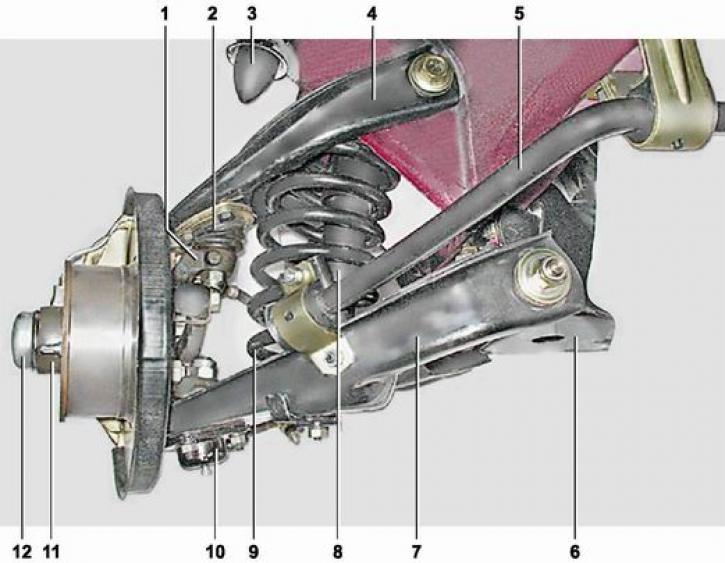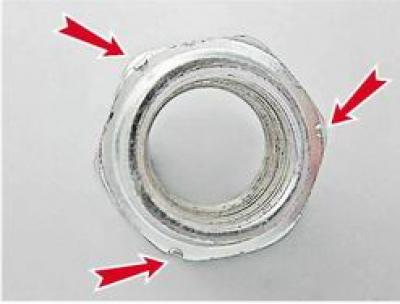
Front suspension details: 1 - steering knuckle (2101-3001014/15); 2 - upper ball joint (2101-2904192-01); 3 - compression stroke buffer (2101-2904230); 4 - upper arm (2101-2904100/01); 5 - anti-roll bar (2101-2906010); 6 - front suspension cross member (2101-2904200); 7 - lower arm (2101-2904020-01/21-01); 8 - shock absorber (2101-2905402-05); 9 - spring (2101-2902712); 10 - lower ball joint (2101-2904082); 11 - hub with bearings (2101-3103002); 12 - hub cap (2101-3101065)
Front suspension - independent on double transverse levers.
The front wheel is connected by four bolts with hub, mounted on two tapered roller bearings. The bearings are mounted in the hub and secured with a nut. The right wheel hub nut has a left-hand thread and is marked with three dots.

Rounded fist with two spherical joints (ball joints) Connected with lower and upper suspension arms. Both arms are stamped from sheet steel, the upper arm is hinged to the body and the lower arm to front suspension cross member - a welded strength element, bolted to the side members of the body. Joints of both levers - rubber-metal (silent blocks), that do not require lubrication. The ball joints are fitted with plastic inserts and filled with grease.
The elastic element of the suspension is a cylindrical spring, passing through the forked upper arm. Its lower end rests on a cup welded to the lower arm. The upper end of the spring rests against the body cup through an insulating rubber gasket. Above the upper arm on the body there is a rubber compression stroke buffer, the upper arm rests against it at maximum suspension travels.
Suspension oscillations are damped by a hydraulic telescopic two-pipe shock absorber, placed inside the spring. With its lower end (reservoir) it is attached to the lower arm through a rubber-metal hinge. Top end (stock) with the help of two rubber cushions it is connected to the shock absorber support cup welded to the body. On the rod inside the shock absorber reservoir there is a rubber bushing - the suspension rebound buffer.
To reduce the roll of the car when turning, the lower control arms are interconnected anti-roll bar - a bent elastic steel rod attached to the lower arms and the body through rubber pads.
The camber angle of the front wheels is adjusted by changing the number of shims placed between the axle of the lower arm and the cross member. Toe-in is adjusted by changing the length of the side tie rods.
Maintenance of the front suspension comes down to monitoring the condition of its parts, adjusting and replacing the lubrication of the wheel bearings, as well as monitoring and adjusting the wheel alignment angles.
